
Fundamentals of Biomedical Engineering
.pdf22 |
FUNDAMENTALS OF BIOMEDICAL ENGINEERING |
30.The corpuscles which are able to eat bacteria and other germs so as to defend the body against disease are ______.((a) RBC (b) WBC
31.The clotting of blood is done by ____. ((a) thrombocyctes (b) leucocytes)
32.Striped muscle tissues are _____ the control of ‘will’. ((a) under (b) not under)
33.The muscles of joints are ______ muscles. ((a) striped (b) unstriped)
34.The alimentary canal, the lungs and the blood vessels have _____ muscles. ((a) unstriped (b) striped)
35.The ______ muscle is found only in the wall of heart. ((a) unstriped (b) cardiac)
36.The study of the parts of the body is ____
and the function of the parts is _____. ((a) physiology, anatomy (b) anatomy, physiology)
37.The vascular system is a closed _____
system. ((a) hydraulic (b) pressure)
38.The heart works as ____ chambers pump. ((a) two (b) four)
39.The heart can be considered as _____ stages pumps. ((a) two (b) four)
40.The respiratory system is a ____ system. ((a) air (b) pneumatic)
41.The ______ is the central information processor of the nervous system. ((a) motor units (b) brain)
42.The _____ is the major organ of the excretory system. ((a) liver (b) kidney)
43.The filtering of the blood for removal of wastage is done in ____. ((a) liver (b) kidney)
44.The digestive system includes ____ and associated glands. ((a) stomach (b) alimentary canal)
45.The digestive pancreatic juice and insulin is secreted by _____. ((a) liver (b) pancreas)
46.Red blood cells are formed in the ______. ((a) liver (b) bone marrow)
47.The valves are found in only _____ ((a) artery (b) vein)
48.Artery takes the blood _____ and vein takes the blood _____ the heart. ((a) away, towards (b) towards, away)
49.A portal system is ______. ((a) vein (b) vein and capillary network)
50.An artery has ______ wall than a vein. ((a) thicker (b) thinner)
|
|
|
|
|
|
ANSWERS |
|
|
|
|
|
|
|
||
1. |
(b) |
2. |
(a) |
3. |
(b) |
4. |
(a) |
5. |
(b) |
6. |
(a) |
7. |
(b) |
8. (b) |
|
9. |
(a) |
10. |
(a) |
11. |
(b) |
12. |
(b) |
13. |
(a) |
14. |
(b) |
15. |
(b) |
16. |
(b) |
17. |
(b) |
18. |
(b) |
19. |
(b) |
20. |
(a) |
21. |
(b) |
22. |
(b) |
23. |
(a) |
24. |
(b) |
25. |
(b) |
26. |
(a) |
27. |
(a) |
28. |
(a) |
29. |
(b) |
30. |
(b) |
31. |
(a) |
32. |
(a) |
33. |
(a) |
34. |
(a) |
35. |
(b) |
36. |
(b) |
37. |
(a) |
38. |
(b) |
39. |
(a) |
40. |
(b) |
41. |
(b) |
42. |
(b) |
43. |
(b) |
44. |
(b) |
45. |
(b) |
46. |
(b) |
47. |
(b) |
48. |
(a) |
49. |
(b) |
50. |
(a) |
|
|
|
|
|
|
|
|
|
|
|
|

CONCEPTS OF PHYSICS, MECHANICS AND FLUID MECHANICS
Difficult we shall do now, Impossible we shall take afterwards.
INTRODUCTION |
MECHANICS |
1.Physics is the study of nature and law. Nature governs with laws and to explain the laws, the science of physics is developed. Physics is concerned with the basic rules which are applicable to all objects whether innert or living. Therefore understanding of physics helps us to apply these laws in the study of bio and medical sciences. No one has been given authority to frame the laws of physics. These laws were discovered while observing the events happening in nature. A falling apple from a tree gave Newton an idea of law of gravitation. Mathematics has given us a concept of induction and deduction reasoning. When a person makes observations or experiments and on their basis, reaches a conclusion, then it is said to be inductive reasoning. Deductive reasoning on other hand, proceeds from assumptions rather than observations. It is usually by inductive reasoning that mathematical results are discovered while they are proved by deductive reasoning.
1.Mechanics is a science which deals with the state of rest or the state of motion of body under the action of forces. The application of this science to actual problems is called applied mechanics. Statics is the branch of mechanics which relates to bodies at rest. Dynamics is the other branch of mechanics which deals with bodies in motion. The analysis of force system on bodies is based on some of basic laws which are fundamental laws of mechanics. First law of motion states that a body tends to stay in state of rest or of uniform motion unless an external force is applied. Second law of motion states that the rate of change of momentum of a body is directly proportional to the applied force and in same direction i.e., force = mass × acceleration.Third law of motion states that for every action, there is an equal and opposite reaction.
2.If all the forces in a system lie in single plane, then it is called a coplanar force system. If the line of action of all forces lie along a
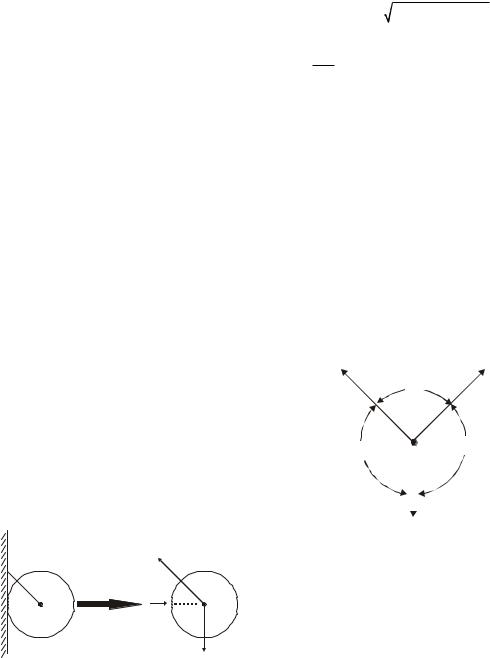
24 |
FUNDAMENTALS OF BIOMEDICAL ENGINEERING |
single line, then it is called a collinear force system. If all forces pass through a single point, it is called a concurrent force system.
3.Moment of a force about a point is the measure of its rotational effect. It is the product of the magnitude of the force and the perpendicular distance of the point from the line of action of the force. The point from where the moment taken is called “moment centre” and the perpendicular distance of the point from the line of action of the force is called “moment arm”
4.Forces on a body can be applied forces and non applied forces. Non applied forces are self weight and reactions. Self weight always act vertically downward and it is equal to the product of mass and gravitational acceleration. Reactions are self adjusting forces developed by other bodies or surfaces which are equal and opposite to forces (actions) exerted by the body. For smooth contact, the direction of reaction is normal to the surface of contact.
5.Free body diagram of a body is a diagram in which the body under consideration is freed from all the contact surfaces with reaction forces and diagram of the body is shown with applied forces and reaction forces at points where body was making contact with other surfaces. Reaction at joints and muscles forces are worked out by drawing free body diagrams.
|
|
|
T |
Free Body |
|
R |
|
|
|
|
|
Diagram |
|
|
|
T |
= |
Tension |
m g |
R |
= |
Reaction |
|
m g |
= |
weight |
|
6.A body is said to be in equilibrium under a
system of coplanar forces if ΣPx = 0 and ΣPy = 0. The resultant of coplanar concurrent forces not in equilibrium is given
by
R = (Σpx)2 + (Σpy)2
and angle of inclination is given by tan–1
ΣPy where Σpx and ΣPy are sum of resolved
ΣPx
forces in x and y directions.
7.A body is said to be in equilibrium under
coplanar force system if ΣPx = 0, ΣPy = 0 and ΣM = 0. Hence we see that the condition of equilibrium gives three equations to find only three unknowns. A system of forces is determinate incase it has three unknowns only, otherwise it is indeterminate. Lami's theorem of equilibrum can be applied for three concurrent forces. According to it, the forces are proportional to sine of the angle between other two forces.
Hence, |
p1 |
|
= |
p2 |
= |
p3 |
||
sin α |
23 |
sin α |
sin α |
|
||||
|
|
|
13 |
|
12 |
|
||
|
P3 |
|
|
|
|
|
P2 |
|
|
|
|
|
α23 |
|
|
|
|
|
|
α13 |
|
|
|
α12 |
||
|
|
|
|
|
||||
|
|
|
|
|
|
|
|
|
P1
8.Friction : When a body moves or tends to move over another body, a force opposing the motion is developed at contact surface. Friction force = coefficient friction force is always less than static friction. Friction can be reduced by lubricating the contacting surface. Dry surface friction is always greater than wet surface friction. Friction can always be reduced if contact between the surfaces can be avoided by keeping a layer of liquid in between the surfaces. Synovial joints in our body work on same principle.
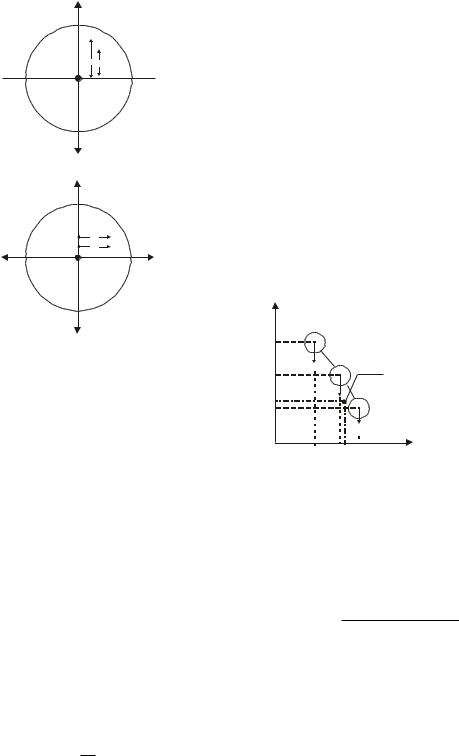
CONCEPTS OF PHYSICS, MECHANICS AND FLUID MECHANICS |
25 |
+y
o ao1a2 y1 y2
–x |
o |
+x |
|
+y |
|
|
|
+y |
|
|
|
x1 |
oa1 |
|
–x |
x2 |
oa2 |
x |
o |
|
||
|
|
|
|
|
–y |
|
|
9.Bending and torsonal stresses: The bending equation is applicable where shear
|
M |
|
E |
σ |
force is zero and it is given by |
|
= |
|
= y |
I |
R |
where M = applied moment, I = moment of inertia, R = radius and curvature, σ = bending stress, E = Young's modulus and y = layer from centre where bending stress is being analysed. Moment of inertia is nothing but second moment of area or mass. Moment of inertia of a lamina is
(a) Moment of inertia about x – x
=Ix = a1 y21 + a2 y22 ..... = Σay2
(b) Moment of inertia about y – y
= Iy = a1x12 + a2x22 .... = Σax2
(c) Moment of inertia of circular section =
πD4
Ixx = Iyy = 64
(d) Moment of inertia of hollow circular section
π
= Ixx = Iyy = 64 (D4 – d4)
Similarly for pure torsion we can apply
T |
= |
τ |
= |
Gθ |
where T = Torque, Ip = polar |
|
I p |
r |
l |
||||
|
|
|
moment of inertia, τ = shear stress r = radius, G = rigidity modulus, l = length and θ = angle of twist.
10.Centre of gravity: The entire mass of a body is assumed to be concentrated at a point and the force of gravity acts at this point which is called the centre of gravity. The centre of gravity of a body is located at a point about which sum of moments of weights of all its particles is zero. Hence if the body is supported at its centre of gravity, the body will remain in rotational equilibrium as the moment of weight of all its particles
about the point of support will be zero.
y |
|
|
|
|
|
|
y1 |
|
m1 |
|
|
|
|
|
|
|
|
|
|
|
y2 |
m 1 g |
|
|
m 2 |
CG (Total weight |
|
|
|
|
|
|||
|
|
|
|
|
=m 1g + m2g + m 3g) |
|
|
|
m 2g |
|
|
|
|
ycg |
|
|
|
|
m 3 |
|
y3 |
|
|
|
|
|
|
|
|
|
mcg |
|
||
o |
|
x2 |
x |
|
x |
x |
x1 |
cg |
3 |
||||
|
|
|
|
|
||
Centre of Gravity of Particles
Consider a body with three particles only with masses as m1 m2 and m3. The moment of three particles at point '0' about y – y axis is equal to m1g
x1 + m2 g x2 + m3 g x3. Total mass of the body at centre of gravity (CG) is m1 + m2 + m3 and moment
of inertia is equal to (m1 + m2 + m3) g × xcg.
Hence, xcg = m1 x1 ++m2 x+2 + m3 x3 m1 m2 m3
=Σ mi xi
Σmi
and ycg = Σ mi yi . There is another method to find
Σmi
the centre of gravity by actually balancing the body
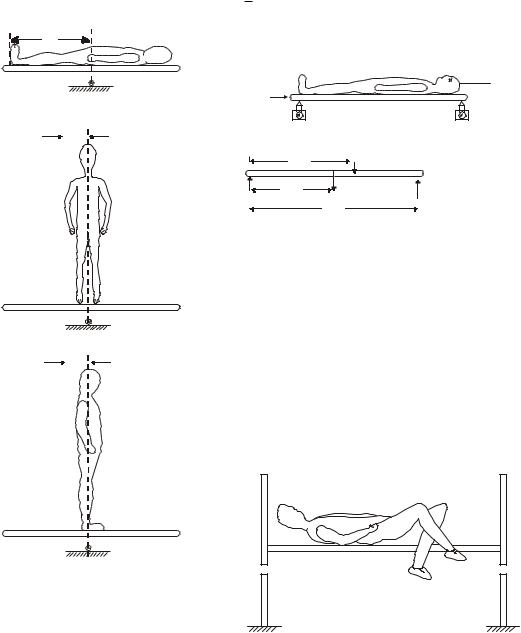
26 |
FUNDAMENTALS OF BIOMEDICAL ENGINEERING |
on a knife edge in three planes i.e., median plane, coronal plane and horizontal plane. The point of balance will give the line in that plane on which the centre of gravity of the body is lying. The intersection of these three lines will give the actual centre of gravity of the body from a point in space. Statistical method can also be used for finding
y
Horizontal Plane
x
Median Plane
z
Coronal plane
the centre of gravity. A man (weight = wm) is lying supine on a board (weight = wb) and reaction force RA and RB are read from the measuring scale. The length of board is 'l' and its weight will act at l/2
while weight of the man acts at xcg from point A. The free body diagram of the body is shown in the figure. Now ΣPy = 0, therefore RA + RB = wm+ wb and wm can be found out. Similarly ΣMA = 0, therefore,
2l × wb + xcg × wm – l × RB = 0, and xcg can be found out. Similarly ycg and zcg can be found out.
W eight of Board m an = wm
weight wb
|
|
|
weighing |
W eighing |
|
|
|
scale |
|
|
|
A |
scale |
|
|
|
B |
||
A |
xCG |
wm |
B |
|
|
|
|||
R |
|
l/2 |
wb |
|
A |
|
RB |
||
|
|
l |
||
11.The centre of gravity of a man depends on the relative position of his limbs (lower and upper) as compared to the anatomical position. Locations of the centre of gravity of upper and lower limbs will change depending upon their positions which will change the overall centre of gravity of the man. If knee is flexed backwards, the centre of gravity of leg as well as that of the man will shift backwards. Smilarly, the centre of gravity of arm as well as the man shifts forward if the elbow is flexed. An athletic can take full advantage by positioning his limbs so as to shift his centre of gravity as high as possible while jumping over the high bar.
Positioning of Limbs to
Help While Jumping
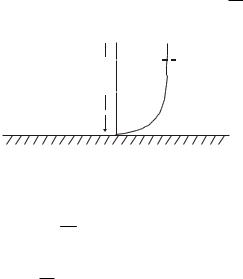
CONCEPTS OF PHYSICS, MECHANICS AND FLUID MECHANICS |
27 |
FLUID MECHANICS
1.Viscosity : It is defined as the property of a fluid which determines its resistance to shearing stresses. It is a measure of internal fluid friction which exerts resistance to flow, It is primarily due to cohesion and molecular momentum exchange between fluid layers which appears as shearing stresses between the moving layers of the fluid when the flow takes place. An ideal fluid one which has no viscosity. But no fluid is exists which can be classified as an ideal fluid having zero viscosity. However fluids with very small viscosity can be considered as ideal fluids. In the figure, a fluid flow is shown on a solid boundary when two layers are 'dy' apart and moving one over the other with different velocities, say 'u' and 'u + du'. The top layer causes a shear stress on the adjacent lower layer and this lower layer also cause a shear stress on the layer lower to it and this goes on. According to Newton's law of viscosity, the shear strees (τ) on a fluid element layer is directly proportion to the rate of shear
du strain or the rate of change of velocity dy .



 u + du dy
u + du dy




 u
u 

 y
y
Solid Boundary
du
τdy
du
τ=µ dy
µ=dynamic viscosity
or µ = |
τ |
= |
stress |
(du/dy ) |
strain |
The viscosity can be defined as shear stress required to produce unit rate of shear strain. The unit of viscosity
Force × Time
=(length)2 Newton Second
=(meter)2
and one poise = 1/10 Ns/m2. Kinematic viscosity is defined as the ratio between the dynamic viscosity and density of the fluid.
Hence, |
v = Viscosity |
= ρ |
||||
|
|
density |
|
|
||
|
(metre)2 |
m2 |
|
|
||
and it has unit = |
|
|
= |
|
. |
|
second |
|
s |
|
|||
|
|
|
|
|
||
One stoke =10–4 |
m2 |
. The fluids which |
||||
|
s |
|||||
follow Newton's law of viscosity are known as Newtonian fluid. Hence fluids can be classified as :
(a) Newtonian fluids : These fluids follow Newton's viscosity equation. For such fluids, µ does not change with rate of deformation. Water, kerosene and air are Newtonian fluids.
(b) Non Newtonian fluids : Fluids which do not follow the linear relationship between shear stress and rate of deformation are termed as non Newtonian fluids. Solutions, suspensions (slurries), mud flows, polymer solutions and blood are examples of non Newtonian fluids. These fluids are generally complex mixture and they are studied under rheology (a science of deformation and flow).
(c) Plastic fluid : Non Newtonian fluid in which initial yield stress is to be exceeded to cause a continuous deformation.

28 |
FUNDAMENTALS OF BIOMEDICAL ENGINEERING |
(d) Ideal fluid : Fluid is incompressible and has zero viscosity. Stress is zero regardless of motion of the fluid.
2.Boundary layer: When a real fluid flows past a solid boundary, the fluid particles adhere to the boundary and the condition of no slip occurs. It means that the velocity of fluid close to the boundary will be same as that of the boundary. In case the boundary is stationary, the fluid velocity at the boundary will be zero. As we move further away from the boundary, the velocity of the fluid will be higher. Due to variation of velocity as we move away from the boundary, a velocity gradient (du/dy) will exist. The velocity of the fluid increases from zero velocity on the stationary boundary to free stream velocity (u) of the fluid in the direction normal to the boundary (y). The theory dealing with boundary layer flow is called boundary layer theory.
Boundary Layer
Flow |
Solid Boundary |
|
Boundary Layer
According to this, the flow in the neighbourhood of the solid boundary may be divided into two regions :
(a) A very thin layer of fluid called the boundary layer is in the immediate neighbourhood of the solid boundary where the variation of velocity exists from zero at solid boundary to free stream velocity in the direction normal to the boundary. In this region, a velocity gradient = du/dy exists and hence the fluid exerts a shear stress on the boundary in the direction of flow. τ (shear stress) = µ du/dy where µ =
viscosity.
(b) The velocity of the fluid outside the boundary layer is constant and equal to the free stream velocity. There is no velocity gradient in this region and hence shear stress is also zero in this region.
3.Flow in tube: When a fluid enters a tube/ pipe from a large reservoir where the velocity is uniform and parallel to the axis of the tube (as shown in the figure), the velocity profile is a flat surface at the entry. Immediately on entry, the fluid velocity in vicinity of the surface of the tube is affected by friction force. However, the velocity profile far from the surface and near the axis of the tube remains still flat (same as free flow). As the fluid moves further in the tube, flat portion decreases and some distance after, a paraboloidal velocity profile for the fully developed flow is reached. The flow at the inlet and flow beyond point A (region
III)is called fully developed flow.
I 
II  III
III
A
I 
Flow Tube and Entry Length
The entry length is defined as the length in which 99% of the free flow velocity is attained. The flow in the entry length portion consists of two parts:
(1)the flow in region I near the tube surface is called boundary layer flow.
(2)the flow in the region II is called core flow (plug flow)
4.Laminar and turbulent flow: The particles move in curved unmixing layers or streams and follow a smooth continuous path in the laminar flow. The paths of fluid movement are well defined and the fluid particles retain
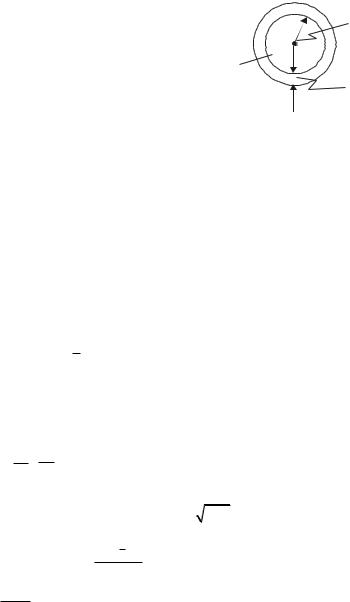
CONCEPTS OF PHYSICS, MECHANICS AND FLUID MECHANICS |
29 |
their relative positions at successive cross sections of the flow passage in the laminar flow. There is no transverse displacement of fluid particles. Soldiers marching in orderly manner is an analogy to laminar flow. In turbulent flow, the motion of fluid particles is irregular. The fluid particles move along erratic and unpredictable paths. The velocity of fluid particle fluctuates both along the direction of flow and also perpendicular to the flow. A crowd of commuters on a railway station rushing for boarding a train is an analogy.
The Reynolds numbers is a dimensionless number which is used to predict whether the flow is laminar or turbulent in a tube. The Reynold's number = Inertial force/ viscous force = ρu2D2/ µuD = ρuD/µ = uDv, where µ = viscosity, v = kinematic viscosity = µ/ρ, ρ = density, u = velocity and D = diameter of tube. If inertia force is much higher than viscous force, Reynolds number will be more and less chance for the flow to be laminar. In a tube, turbulent flow occurs when Reynolds number > 6000. For laminar flow in a tube, following are applicable:
(a) Strear stress τ = – ∂∂Px . 2r where r =
∂P
radius of layer and ∂x = Pressure gradient along direction of flow.
(b) Velocity u = – 4µ1 ∂∂Px (R2 – r2) where R = radius of tube, r = radius of layer
(c) Ratio of maximum velocity to average velocity = 2
32 µu L
(c) Loss of pressure head = ρ g D2
Flow
where u = Area and L = Length of flow.
5. The tube must have same thickness of the
wall depending upon the pressure of the
fluid. Thickness (t) = |
Pr |
where P = |
σp |
pressure, r = radius and σp = permissible stress
Radius = r
Pressure (p)
Thickness = t
Thin Tube
6.Equation of continuity and Bernaulli's equation. The total mass of fluid going inside the tube through any cross section remains same. Therefore the equation of
continuity is A1u1 = A2 u2, where A stands for cross sectional area and u stands for velocity. As per Bernaulli's equation, the total head of the fluid remains constant at every cross section of the tube. The Bernoulli's
equation |
is |
1
P + 2 ρu2 + ρgh = constant where
P = pressure, ρ = density, g = coefficient of gravity, h = height of cross section from a datum line and u = velocity of the fluid.
7.Applications of Bernaulli's equation. The speed of liquid coming out through a hole in a tank at a depth 'h' below the free surface is the same as that of a particle falling freely through the height 'h' under gravity i.e., u =
2gh . This is known as Torricelli's
theorem. When a person is bleeding, we try to reduce 'h' so that blood flow can be reduced. Other application is Aspirator pump which works on the principle that the pressure of fluid decreases where ever its speed increases. As shown in the figure, the air is pushed through a narrow opening at
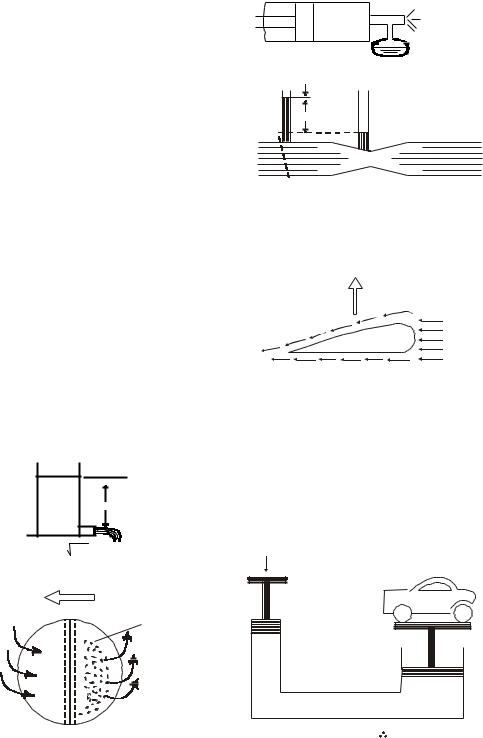
30 |
FUNDAMENTALS OF BIOMEDICAL ENGINEERING |
'A' resulting in drop of pressure. The liquid in the bowl is raised by the pressure drop and liquid is sprayed with the expelled air. A cricket ball having a shining side and rough a side on the left and right as shown in the figure will deviate towards the shining side as air passing over the shining side will face less resistance and gain more speed resulting in lower pressure as compared to the rough side. Similarly, an aerofoil has longer distance at the top surface as compared to the bottom surface which makes the air move at higher speed at the top surface as compared to the bottom surface resulting in lower pressure at top the surface and higher pressure at the bottom surface which provides a lift to the aerofoil. A venturi tube is used to measure the flow of speed of a fluid in a tube. The tube has a constriction (throat) which makes the fluid flow at higher speed resulting in drop of pressure at throat. The pressure P1 – P2 = ρg (h1 – h2) as shown in the figure. Also
v22 – v12 = 2g(h1 – h2) where v1 and v2 are velocities. Knowing A1and A2 (areas), the
rate of flow of liquid past a cross-section can be found out.
|
h |
|
u |
u = |
2gh |
Torricell's Theorem |
|
|
Deviation |
Shining |
Rough |
v1 |
v2 |
v1 > v2
Cricket ball
A |
Liquid spray |
|
bowl |
Aspirator Pump
Constriction h1 – h2 
P1 |
P 2 |
v1 |
v2 |
h1 |
h2 |
Venturi Tube
Lift
v1
v1 > v2
v2
Aerofoil
8.Pascal's law : If the pressure in a liquid is changed at particular point, the change is transmitted to the entire liquid without being diminished in magnitude. Pascal's law has several applications like hydraulic lift and reaction force at the joints of our body as shown in the figure.
F |
|
|
|
|
|
|
|
|
W |
A1 |
P 1 |
A 1 |
= F |
|
|
|
|||
|
P 1 |
A 2 |
= W |
A2 |
P1 = PRESSURE CONSTANT |
||||
Area A2 >> A 1 |
W >> F |
|||
Hydraulic Lift
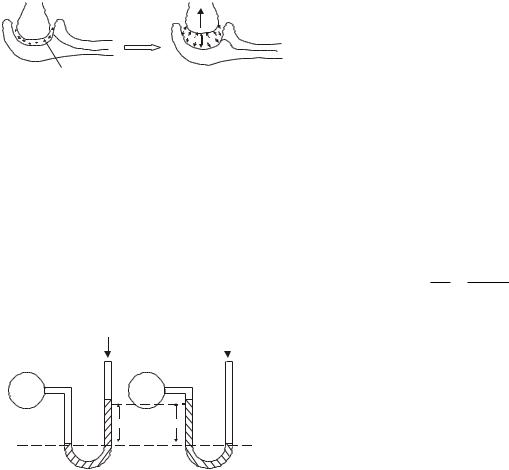
CONCEPTS OF PHYSICS, MECHANICS AND FLUID MECHANICS |
31 |
Reaction R is always vertical due to R
uniform fluid pressure
FBD
Fluid
Reaction Force at Joint
9.Gauge pressure : The standard atmospheric presure is defined as the pressure produced by a column of mercury of 760 mm high.
Hence Patm = ρgh = (13.6 × 103) × 9.8 ×
760 |
= 1.01 × 105 pascal = 1.01 bar. |
|
1000 |
||
|
Pressure of the vessel can be higher or lower than atmospheric pressure. Pressure is measured by a manometer. Manometer is a U-tube with one end opens to atmosphere and other is connected to vessel.
Patm |
|
Patm |
|
Pabe |
Pabs |
hg |
hv |
P |
abs |
= P |
atm |
+ Gauge Pr |
Pabs = P atm – Vacuum Pr |
|
|
|
|
|
= Patm – ρHG × hv × g |
||
|
|
= Patm + ρHG × hg × g |
||||
|
W here h |
g |
= height |
where hv = vacuum height |
||
|
|
|
|
|
|
|
If pressure in vessel (Pabs) is lower than Patm, mercury is forced into the limb connected to vessel. Higher than atmospheric pressure is known as gauge pressure while lower pressure than atmospheric pressure is called vacuum pressure. The flow in cardiovascular system is higher than atmospheric pressure and flow at various places is given by gauge pressure only. The blood pressure of a healthy person is 120/80mm Hg (gauge pressure) during systole/diastole.
TEMPERATURE
1.Temperature is an intensive property of a system (intensive property does not depend upon mass) and indicates relative hotness or coldness from the reference states. Boiling point and freezing point of water are acceptable reference states. Thermometer is a temperature measurement system which can show some change in its characteristics (termed as thermometric property) due to heat interaction taking place with the body whose temperature is being measured. Temperature is measured either in centrigrade or fahrenheit for human body. The relation between these two
thermometers is Tc = Tf – 32 where Tc =
100 180
temperature in centrigrade, and Tf = temperature in fahrenheit. Both theromometers are mercury scale thermometers in which length of mercury column is proportion a to temperature of the body. The normal oral (mouth) temperature of a healthy person is about 37°C or 98.6°F. The underarm temperature is one degree lower, whereas the rectal temperature is one degree higher than that of oral temperature. The temperaure of body is controlled by the body so that it remains constant as 37°C. However during fever, the temperature of body increases as temperature control mechanism fails, thus causing additional metabolism because higher temperature inside the body accelerates the chemical reactions. During fever, shivering takes place as the blood does not flow to skin and muscle tissues which is essential to keep them warm. When body temperature falls to normal temperature, increased sweating takes place as additional heat is eliminated.
